Air Enforcement
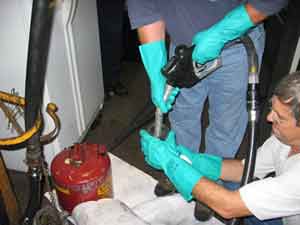
The CAA prohibits any vehicle or engine from being imported or sold in the U.S. without EPA certification that it meets applicable emission standards.

The CAA requires that construction sites and other facilities take steps to control dust (particulate matter) from industrial and construction activities.
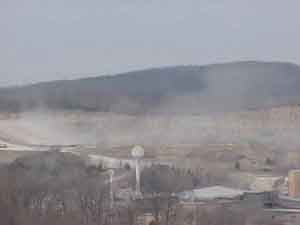
Dust and other airborne particulates are a serious threat to human health. The elderly, children, and people with asthma are especially sensitive to the effects of dust.
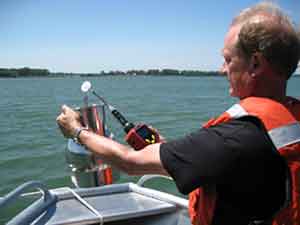
EPA inspector tests for volatile organic emissions that may be coming from a nearby industrial facility. Inspector collects the sample in a SUMMA canister.
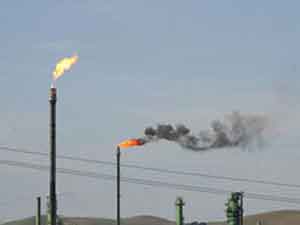
EPA enforcement efforts focus on reducing flaring from industrial activities reducing pollutant emissions including volatile organic compounds and soot.
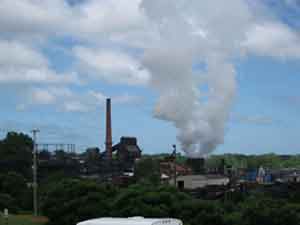
EPA inspects stationary sources of air pollution, such as power plants and factories, to evaluate compliance with applicable requirements under the Clean Air Act.
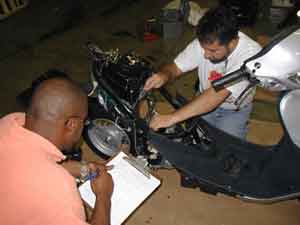
EPA works with U.S. Customs to inspect imports of recreational vehicles, including scooters and motorcycles, from China and other countries.
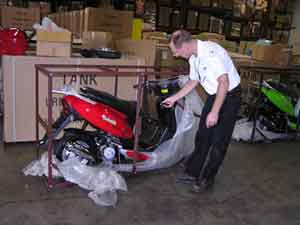
The CAA prohibits any vehicle or engine from being imported or sold in the U.S. without EPA certification that it meets applicable emission standards.

EPA operates a mobile remote sensing laboratory to test for air pollutants at the fence lines of industrial facilities, residential areas, and other off-site locations.
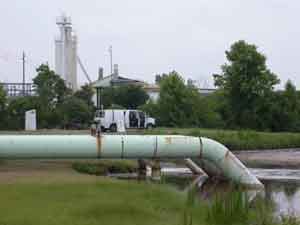
Remote sensing equipment can be used to measure benzene, dust, and other pollutants that may drift downwind of refineries and other industrial facilities.
Información relacionada disponible en español (Related Information in Spanish)
EPA regulates emissions of air pollution from mobile and stationary sources under the Clean Air Act (CAA). For more on EPA's enforcement process, go to Basics on enforcement.
On this page:
On other pages:
- Air Enforcement Policy, Guidance and Publications
- Search for air cases and settlements
- Find air enforcement data
Stationary Sources
Stationary sources include facilities such as factories and chemical plants, which must install pollution control equipment and meet specific emission limits under the CAA.
New Source Review (NSR) and Prevention of Significant Deterioration (PSD). These requirements require certain large industrial facilities to install state-of-the-art air pollution controls when they build new facilities or make modifications to existing facilities. Failure to install controls results in emission of pollutants that can degrade air quality and harm public health. Learn more about New Source Review.
Reducing air pollution from the largest source of emissions is one of EPA's national enforcement initiatives. EPA is taking action to eliminate or minimize emissions from coal-fired power, acid, glass and cement plants and petroleum refineries.
-
Coal-fired power plants. There are approximately 1,100 coal-fired electric utility units in the United States with an overall capacity of 340,000 megawatts. This sector emits approximately two-thirds of the nation's emissions inventory of sulfur dioxide (SO2) and approximately one-third of the nitrogen oxides (NOx). Investigations of this sector have identified a high rate of noncompliance with NSR/PSD when old plants are renovated or upgraded. Learn more about Sulfur Dioxide and Nitrogen Dioxide.
-
Plants that manufacture sulfuric and nitric acid, which are used in fertilizer, chemical and explosive production. Acid production plants emit many thousands of tons of nitrogen oxides, sulfur dioxide, and sulfuric acid mist each year. EPA investigations have found a high rate of non-compliance with NSR/PSD in connection with plant expansions and process changes.
-
Glass manufacturing plants. There are approximately 125 large glass plants operating in the United States. These plants emit approximately 200,000 tons per year of NOx, SO2 and particulate matter (PM). Investigation of this sector has shown that there have been a significant number of plant expansions but few applications for the installation of pollution controls required under NSR/PSD.
-
Cement manufacturing plants. Cement manufacturing plants are the third largest industrial source of air pollution, emitting more than 500,000 tons per year of SO2, NOx and carbon monoxide. EPA determined that many cement manufacturers made changes to existing facilities without applying for and obtaining pre-construction permits. The pollution can contribute to respiratory illness and heart disease, the formation of acid rain, reduced visibility, and can be transported over long distances before falling on land or water.
- Petroleum refineries. Since 2000, EPA has engaged in an enforcement initiative specifically focused on addressing air emissions from petroleum refineries and has reached innovative, multi-issue, multi-facility settlement negotiations with major petroleum refining companies. These settlements have resulted in significant emission reductions of NOx, SO2, benzene, volatile organic compounds and PM.
Air Toxics. National Emission Standard for Hazardous Air Pollutants (NESHAP). Leaks, flares, and excess emissions from refineries, chemical plants and other industries can contain hazardous air pollutants (HAPs) that are known or suspected to cause cancer, birth defects, and seriously impact the environment. Leaking equipment is the largest source of HAP emissions from petroleum refineries and chemical manufacturing facilities. Cutting emissions of air toxics EPA's National Enforcement Initiatives.
New Source Performance Standards (NSPS). Newly constructed sources or those that are modified or reconstructed must follow these standards to control excess emissions of NOx, SO2, and particulate matter.
Mobile sources
Motor vehicle engines and off-road vehicles and engines must meet CAA emissions standards. These standards apply to cars, trucks, buses, recreational vehicles and engines, generators, farm and construction machines, lawn and garden equipment, marine engines and locomotives. In addition, the composition of fuels used to operate mobile sources, including gasoline, diesel, ethanol, biodiesel and blends of these fuels, are also regulated under the CAA. Learn more about transportation and air quality.
New vehicles and engines must have an EPA-issued certificate of conformity before import or entry into the United States demonstrating that the engine or vehicle conforms to all applicable emissions requirements. The CAA also requires emissions labels for certified vehicles and engines. See examples of cases and settlements related to vehicles and engines.
-
Illegal imports. Since 2008, there has been a steady flow of illegally imported uncertified motorcycles, equipment containing small gasoline-powered engines (e.g., generators, mowers, chainsaws, etc.), and recreational vehicles. Uncertified vehicles and engines can emit harmful air pollutants at 30% or more above allowable standards. EPA is working with U.S. Customs to stop illegal vehicles and engines at the ports and requiring exportation. Learn more about importing vehicles and engines.
-
Defeat devices. It is a violation of the CAA to manufacture, sell, or install a part for a motor vehicle that bypasses, defeats, or renders inoperative any emission control device. For example, computer software that alters diesel fuel injection timing is a defeat device. Defeat devices, which are often sold to enhance engine performance, work by disabling a vehicle's emission controls, causing air pollution. As a result of EPA enforcement, some of the largest manufacturers of defeat devices have agreed to pay penalties and stop the sale of defeat devices.
-
Tampering. The CAA prohibits anyone from tampering with an emission control device on a motor vehicle by removing it or making it inoperable prior to or after the sale or delivery to the buyer. A vehicle's emission control system is designed to limit emissions of harmful pollutants from vehicles or engines. EPA works with manufacturers to ensure that they design their components with tamper-proofing, addresses trade groups to educate mechanics about the importance of maintaining the emission control systems, and prosecutes cases where significant or imminent harm is occurring.
Fuels. The CAA regulates fuel used in motor vehicles and non-road equipment. Clean fuels help reduce harmful emissions from a wide variety of motor vehicles, engines, and equipment.
-
Standards. EPA regulations require that all fuel and fuel additives produced, imported and sold in the United States meet certain standards. EPA conducts targeted and random inspections to evaluate compliance with these standards, and brings enforcement actions against parties that violate these standards to reduce harmful emissions caused by fuel that does not meet the applicable standards. See diesel and gasoline fuels enforcement actions.
-
Renewable Fuels. Transportation fuel sold in the U.S. must contain a minimum volume of renewable fuel to reduce greenhouse gas emissions and the use of petroleum fuels. Renewable fuel producers and importers generate renewable identification number (RINs) for each gallon of renewable fuel. Refiners and importers must acquire RINs to show compliance with the standard. EPA investigates and pursues enforcement actions against anyone generating, transferring and using invalid RINs. Learn more about renewable fuels. See Renewable Fuels Standards enforcement actions.
- Fuel Waivers. EPA, with the concurrence of the U.S. Department of Energy (DOE), has the authority to temporarily waive fuel or fuel additive requirements in emergency situations when the fuel supply suffers major disruptions. This helps ensure that an adequate supply of fuel is available, particularly for emergency vehicle needs. In such circumstances EPA works closely with state and other federal agencies to determine an appropriate response.
Ocean-Going Vessels and Large Ships. The CAA regulates new and in-use U.S. flagged compression-ignition marine engines (also called marine diesel engines), vessels containing such engines, emissions from such engines, as well as the sulfur content of marine fuel. EPA’s strategy to address emissions from all ships that affect U.S. air quality includes enforcement of CAA standards, as well as implementation and enforcement of the international standards for marine engines and their fuels contained in Annex VI to the International Convention on the Prevention of Pollution from Ships (a treaty called MARPOL) under the authority of the Act to Prevent Pollution from Ships (APPS).
-
Enforcement of MARPOL Annex VI. The EPA and the U.S. Coast Guard (USCG) agreed to jointly enforce U.S. and International air pollution requirements for vessels operating in U.S. waters. Learn more about MARPOL Annex VI.
-
Engine and Fuel Standards. EPA regulates air pollution from various marine diesel engines. EPA has adopted standards that apply to Category 3 (C3) engines installed on U.S. vessels, such as large ships and ocean vessels, and to marine diesel fuels produced and distributed in the United States. Learn more about other marine diesel engines.
Compliance Monitoring and Assistance
EPA works with its federal, state and tribal regulatory partners through a comprehensive Clean Air Act compliance monitoring program. Compliance monitoring ensures that the regulated community obeys environmental laws/regulations through on-site inspections and record reviews that can lead to enforcement when necessary. The CAA compliance assistance program provides businesses, federal facilities, local governments and tribes with tools to help meet environmental regulatory requirements.


